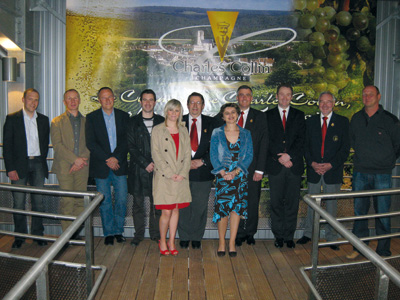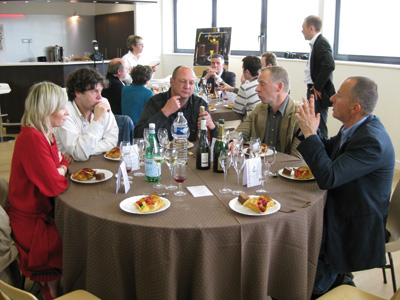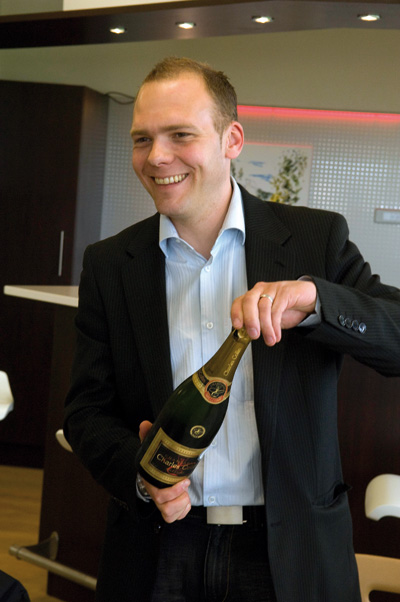Winegrower Champagne From Renoir
to Charles Collin
Champagnes
Essoyes : an inexhaustible
source of inspiration
Artists’ lives often reveal to be as fascinating as their work and Pierre Auguste Renoir is no exception to the rule. The old village of Essoyes, built on the banks of the Ource river in the Aube region, even if not much mentioned in the numerous books about Renoir, played a key role in his career and personal life. Fifty years ago, the French magazine Paris Match already deplored that “no one ever talks about this small wine grower village lost at the border between Champagne and Burgundy where Renoir spent however endless summers painting”. But yet Renoir painted the landscapes, the houses and the people of Essoyes hundreds of times. Renoir was indefinitely inspired by the character and authenticity of the village. Nowadays, this terroir communicates the same passion to the artists of vinification of the House Charles Collin.

 Au cœur de la nouvelle cuverie à Essoyes ,
Au cœur de la nouvelle cuverie à Essoyes ,
les Sommeliers de Champagne, le Centre Culturel Renoir…
Alongside the wine growers
Today there is no Gamay anymore and the terroir of Essoyes is now planted with 90% Pinot Noir and 10% Chardonnay, the Pinot Meunier only representing less than five hectares. The chalky and clayey soils produce wines with a good acidity guaranteeing a good ageing capacity. The champagnes offer optimum maturity and strength yet freshness. If in Renoir’s times, wine growers only cared about their vines, nowadays, the House Charles Collin decided to also involve them in the vinification process. The house makes each owner more aware of the analysis of his vineyard, offers him an advanced technical service and helps him during the maturing and harvest…
“The quality of a champagne depends on the quality of the grapes. Cooperating allows each one to feel mobilized and to produce the best grapes, thus the best Champagnes” Guillaume Cartier, Cellar Master, explains.
In a progress and development process, Charles Collin inaugurated in Fontette in 2006 a new pressing and vinification centre with presses and thermo-regulated stainless steel vats of different sizes to better select and isolate the grapes. In 2009, in Essoyes this time, the house invested in a very good winery. Charles Collin’s credo
“the best of modernity for the best tradition” is respected. In a concern for aesthetics, the vathouse receives nice natural lighting. Wide windows show the Aube region soil’s layers, so sensitive to rain supply. The tasting room offers an unrivalled panorama on Essoyes, its vineyards, its terroir, and each guest, as he enjoys a glass of champagne, can let himself carry along by the landscape and the aromas of the Champagnes Charles Collin. The latter are regularly awarded and selected by prestigious guides. The last one: the Cuvée
“Charles” 2002 got a Silver Medal at the Vinalies Internationales 2010. Made of 100% Chardonnay, this cuvée has been able to wait in the cellar before developing today all the fineness and elegance of a high quality champagne.

For further information: Centre Culturel Renoir: BP 21 – 10360 Essoyes
www.renoir-aube-champagne.com • Quand Renoir vint paysanner en Champagne by Bernard Pharisien, Editions Némont à Bar-sur-Aube.
• Les Matinales d’Essoyes: http://renoir.chez.com/matinales.htm
Discover the whole range of Charles Collin champagnes
on the spot or on their website:
www.champagne-charles-collin.fr
Renoir and wine
Pierre Auguste Renoir lived for thirty years in Essoyes where his wife, Aline, born Charigot, came from. They met in Paris in a cheese shop where they used to have lunch; she was a young dress designer, and he was a recognized artist, eighteen years older than she. Since then Aline Charigot was forever willing to go back to her roots. Over their stays in the Aube region, Pierre Auguste Renoir fell in love with the charm and calm of this undulating countryside. It is in the “upper quarter”, the wine makers’, that Renoir, who was already famous and rated, bought his first house. The rumour says that in his garden were growing vines of Gamay that phylloxera destroyed… Though Pierre Auguste Renoir never really took an interest in the vine, he led his social life in the company of wine growers who became sincere friends of his’.
In a memoirs collection, Jean Renoir recalls his father in these words: “His taste in wine was the same as his taste in art and the blended wines of Bercy appeared to him to be as depressing as mass-produced furniture. He wanted to meet the wine grower and his vines through his wine, as he wanted to meet the painter and the bit of nature that had inspired him through a painting1…” A vision of wine shared by the House Charles Collin which sense of service towards the wine grower leads it to produce the best of the terroir.

Guillaume Cartier, Chef de Cave.
Get a taste of Renoir’s world
The Renoir Cultural Centre will open in January 2011. This new cultural and tourist attraction, elected
“Rural Centre of Excellence”, aims at highlighting the resources in a preserved environment as much as developing the local economy. From his paintings to his studio, visitors will discover the exhibition around Renoir’s
“taste for the others”, true emotional nourishment for him.
Karine Rémy, the manager, expects 24,000 people for the first year.
In summertime, the tourists will enjoy the Matinales d’Essoyes [Mornings of Essoyes] lead by
Bernard Pharisien, great-nephew of Gabrielle, Renoir’s most famous model. They will discover part of the rich heritage of Essoyes by following Bernard Pharisien, passionate and fascinating connoisseur; a nice introduction to the region before tasting its champagnes, as the
Association of Sommeliers of Champagne did recently.
Hélène Dabjat
1. Pierre Auguste Renoir, Mon père by Jean Renoir – Gallimard Folio.


